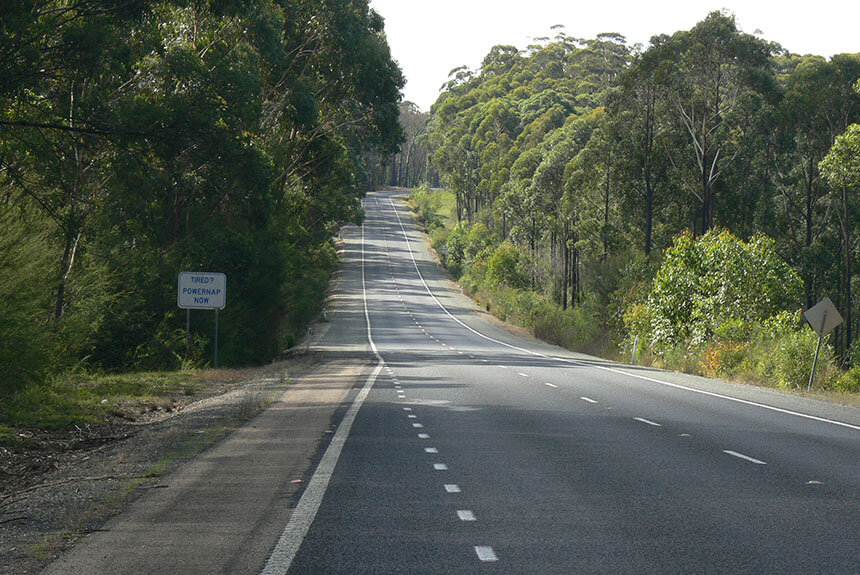Following the route’s closure for much of the recent summer season as a result of bushfire, the Orbost and District Chamber of Commerce and Industry (ODCCI) has highlighted the importance of continuing to maintain clear roadsides along the Princes Highway through East Gippsland.
At its monthly meeting on April 21, the ODCCI moved a motion stating its support for the safety, and tourism benefits, of a well-maintained thoroughfare.
“We moved that the chamber support the proposal for the completion of the roadside clearing operations on the Princes Highway from Nowa Nowa to the New South Wales border to create a strategic fuel break, improve the safety of the highway for vehicles and to minimise the disruption to traffic following fire and storm events,” ODCCI secretary, Garry Squires, said.
The proposal recommends that the creation of a strategic fuel break along the major arterial road be recognised as a major strategic project for East Gippsland and that funds be allocated to complete the project.
The Princes Highway through East Gippsland is a major transport and supply route linking Victoria to south east NSW and Sydney and provides access and egress for emergency services and communities during bushfires and other emergency events. It is also a major tourist route.
Chamber members said the management of roadside vegetation along this section of the highway has over many years been a major concern for the community, the transport industry, firefighters and other emergency services workers.
Identified as a key route, its maintenance before, during and after fire should be one of the priorities for any state, regional or municipal fire management plan.
A report prepared by the Department of Sustainability and Environment (DSE) in 2012 identified a number of issues along the road:
- Long stretches with minimal verge.
- Vegetation growing to the edge of the road and in some cases overhanging the road.
- Understory and eucalypt regrowth that has been allowed to regrow and progressively creep towards the bitumen.
- Hazardous trees close to the bitumen.
The volume of vegetation and hazardous trees close to the bitumen had the added risk of potentially falling and seriously injuring members of the travelling public or firefighters and other emergency service personnel following fire or storm events.
The 2012 report identified the section of road as having had frequent closures for periods from a few hours to days. As a result of the summer 2020 bushfires, the section was closed for almost five weeks.
The ODCCI sees this as an unacceptable impost on the transport industry and the local communities relying on the road for access and for these reasons say the requirement for a permanent fuel break along the length of highway has widely been acknowledged by emergency service workers and the community as a key project.
The 2012 DSE report included a project plan for the Princes Highway fuel break, which included the removal of all vegetation on the original highway footprint and along each side of the road, removal of hazardous trees up to two tree lengths from the roadside and smoothing and forming of the cleared area for follow up slashing.
In its support of maintaining clear roadside the chamber identified two types of events that potentially impact the highway and create significant safety issues and close the road for varying periods of time - trees randomly falling across the road or as a result of wind storms and wildfire, where cleared roadside would operate as significant fire beaks.
After the recent fires crossed the Princes Highway in multiple locations there were many burning and dangerous trees along the edge of the highway. Clearing the vegetation to make the highway safe to reopen took five weeks.
LONG-TERM RESILIENCE
Federal Member for Gippsland, Darren Chester, is supporting the ODCCI proposal.
Mr Chester said the highway’s monthlong closure during the summer bushfires had taken a huge toll and the highway needed to be made more resilient.
“We lost jobs, lives were put at risk and our community was placed under additional pressure because the highway was closed for too long after the bushfires,” he said.
“The Princes Highway is the critical transport artery of East Gippsland and a vital link from Gippsland to southern New South Wales and Canberra, and from East Gippsland to Melbourne.”
Mr Chester said the highway’s closure had a huge impact on towns, communities, businesses and families who rely on that stretch of the highway and the entire east coast transport industry.
He has welcomed the salvage of trees that were felled in the aftermath of the bushfires, but believes there needs to be a greater focus on the longterm resilience of the transport corridor.
“The highway is a crucial piece of transport infrastructure and it must be able to withstand the impact of events such as major bushfires,” Mr Chester said.
He said the Princes Highway was owned and managed by the Victorian Government, so a project of this nature would require State Government approval.
“I want East Gippsland to build back better than it was before the fires,” Mr Chester said.
“To help support this proposal from the Orbost Chamber of Commerce, I have written to the Federal Minister for Agriculture, Drought and Emergency Management David Littleproud to seek funding as part of Gippsland’s bushfire recovery.”
IMAGE: Some sections of the Princes Highway between Nowa Nowa and the New South Wales border have vegetation to the edge of the road easement on both sides. Orbost and District Chamber of Commerce and Industry is supporting the proposal to complete roadside clearing for safety and minimisation of traffic disruption. (PS)
